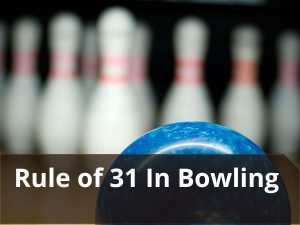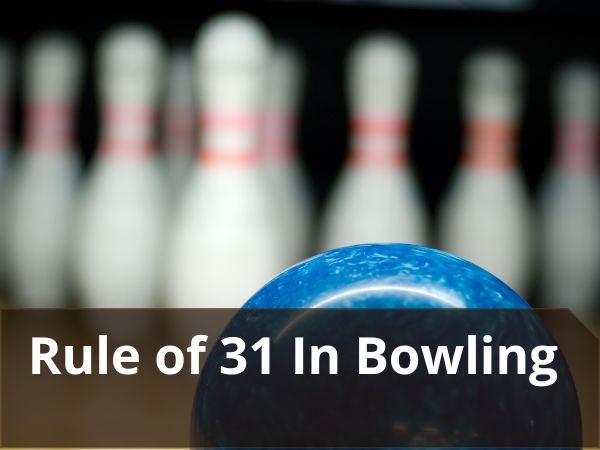Rule Of 31 In Bowling! Once you start bowling regularly, it is only a matter of time till you will be introduced to the “Rule of 31”. So what is this Rule of 31 exactly? How does it help a bowler to score better? I know you probably have tons of questions circulating in your head. If you aren’t familiar with the rule (well, it’s basically a technique)
yet, I think, it’s time, you know the ins and outs of it. After all, who doesn’t love to make their life easier? Especially, if it is a sport you’re passionate about.

If you’re someone who struggles to understand where to start on the lane, this article is just for you. So, here comes the in-depth discussion on ‘Rule of 31’.
What is the bowling rule of 31?
The bowling rule of 31 is a scoring system used in some informal bowling games. It is often played in a casual setting where players aim to reach a score of exactly 31.
The Rule of 31 in bowling is a strategic guideline used to determine the optimal breakpoint on the lane based on the oil pattern length. Here’s a summary in bullet points:
- Purpose: Helps bowlers identify where the ball should exit the oil pattern for the best chance to hook into the pocket and strike.
- Calculation: Subtract 31 from the length of the oil pattern (in feet) to find the target board for the ball’s exit point.
- Example: For a 40-foot oil pattern, 40 – 31 = 9. Aim for the ball to exit the oil at the 9th board.
- Application: More applicable to sport or competitive oil patterns than typical house patterns.
- Adjustments Needed: Bowlers may need to adjust based on real-time lane conditions, oil pattern breakdown, and personal bowling style.
- Limitations: Not infallible, especially on shorter or very long patterns, and it’s more effective on sport patterns than house patterns.
- Guideline, Not Rule: Considered a starting point or guideline rather than a strict rule to be followed without consideration of other factors.
- Factors Affecting Effectiveness: Includes the bowler’s speed, rev rate, the specific characteristics of the bowling ball, and the physical condition of the lane.
Here’s how it works:
- Each player takes turns rolling the ball down the lane, trying to knock down as many pins as possible.
- The number of pins knocked down on each turn is added to the player’s score.
- If a player knocks down more than 31 pins with their score, their score is reset to zero.
- The first player to reach exactly 31 points wins the game.
It’s important to note that the bowling rule of 31 is not a standard rule used in official bowling competitions or leagues. It is simply a fun variation of the game played in a more relaxed and social setting.
The “Rule of 31” is an equation that was developed to help bowlers determine the approximate breakpoint on the lane. This formulated equation helps you to calculate where your breakpoint is going to be when it exits the oil pattern. When you use this equation, you know where your bowling ball will make a move for the on-point hooking angle right before it gets into the pocket and hits the pins.
This equation of this rule of 31 requires you to know the pattern length and subtract 31 from that. The result you will get is the number of the board where your ball is going to exit the oil pattern. When you face a completely unfamiliar bowling oil pattern, the rule of 31 is actually a great way to know where to begin.
How to target breakpoints by using the rule of 31?
It is important to know where your breakpoint is going to be on the lane, even before you throw the ball down the lane. When you can figure out an approximate breakpoint things do get easier. But there are a few factors you have to keep in mind. The kind of surface your selected bowling lane has, the kind of conditioner applied on the lane, the type of bowling balls you use, and its coverstock finish, etc. affect your ball’s breakpoint on the lane.
Hence, you need to set your target on the bowling lane very carefully. If I have to paint a complete picture to make you understand better, here is an example.
Let’s assume, you’re about to throw your bowling ball on the Route 66 oil pattern that runs 45 feet in length. But how would you know that? One simple and easy way is to take a look at the pattern sheet. If a bowling alley lays down any new or special oil pattern, they always provide bowlers with a printed copy of the pattern sheet.
Once you have that with you, I want you to observe three main things from the graphs. One is the Volume of oil, the second thing to notice is the length of the pattern you’re about to encounter, and lastly, the oil ratio of the pattern.
First thing first, take a look at the length of the pattern. It will say 45 feet. So that gives you the pattern length (PL)= 45 feet. Now, all you have to do is make a basic mathematical calculation and subtract 31 from the PL value 44. So, 45-31 = 14. This number indicated the number of boards (by width) where your bowling balls will exit the oil pattern on the bowling lane.
Now, what if it was a 38 feet oil pattern? The rule of 31 will be used to determine your approximated breakpoint on the lane. So just subtract 31 from 38, 38-31 = 7. So, you’re most likely to see the breakpoint on the 7th board on this pattern. One thing you might have noticed here is that, the longer the pattern, the breakpoint is going to move closer to the headpin, and the shorter the pattern, the more outside the breakpoint is going to take place.
Once you figure out your approximate breakpoint, time to get the right bowling ball. If you think you have to start a bit outside, don’t go for an aggressive ball, but the one that hooks gently. If you are to play from the inside, get a ball that goes a little straighter and still hit the ball hard enough. That’s why knowing the oil ratio and the oil volume are also important.
Advanced bowlers at the Kegel Training Center, professional bowlers who are in leagues or often participate in tournaments, and even amateur bowlers have learned their way around the “Rule of 31”. they have figured out how to set their targets to score maximum strikes. Despite how difficult a bowling lane is, they have been using this simple equation for their striking advantage. Worldwide, it has been proven that this technique is incredibly effective, and so, you can use it to achieve precision and get strikes as well.
Does the rule of 31 always apply?
Well, this is a debate that has been going on for quite some time. Some professionals claim that it is a big mistake to completely rely on the “rule of 31”. Why? Because sometimes sticking to the outside the entire time messes up your shot. And the same goes for when you have been playing on the inside for too long. As you keep on playing, your lane starts to break down, so you have the flexibility to move further outside or a bit more inside. Rule of 31 doesn’t apply in these cases.
So one easy hack is to use this rule only at the beginning of your game, or on a freshly applied oil pattern. Make adjustments whenever it is needed. These adjustments are also required at the beginning of your game, in some oil patterns, but not always.
FAQs Of Rule Of 31 In Bowling!
What exactly is the Rule of 31?
- The Rule of 31 is a formula used to help bowlers approximate the board where their ball should be when it exits the oil pattern. For instance, if the oil pattern is 40 feet long, subtracting 31 gives you 9, indicating that your ball should be over the 9th board at the exit point of the oil pattern.
Does the Rule of 31 always apply?
- While the Rule of 31 is a useful starting point, it’s not infallible and doesn’t always apply, especially on shorter or very long patterns, and it’s more suited to sport patterns than typical house shots. The rule provides a general guideline but should be adapted based on actual lane conditions and personal bowling style.
How do oil patterns affect the Rule of 31?
- Oil patterns play a crucial role in how a bowling ball behaves on the lane. The length of the oil pattern influences the ball’s exit point and its trajectory towards the pins. Shorter patterns typically result in the ball exiting closer to the center or left, adjusting for reduced skid length and early hooking, while longer patterns suggest targeting a board further to the right, compensating for extended skid before hooking.
What are the phases of ball motion in bowling?
- A bowling ball goes through three phases of motion on the lane: skid, hook, and roll. The skid phase is when the ball moves straight at its fastest speed. The hook phase is when the ball starts to curve towards the pins, and the roll phase is when the ball slows down, rolling end-over-end towards the pins. Understanding these phases is essential for applying the Rule of 31 effectively.
Is the Rule of 31 reliable for all types of bowlers?
- The Rule of 31 is more commonly applicable to sports shots and professional tournaments. It might not always be reliable for recreational or house lane conditions due to variations in oil pattern lengths and conditions. Bowlers should use it as a guideline rather than a strict rule, adjusting their play based on the specific conditions of the lane and their personal experience.
Conclusion
The Rule of 31 has a great reputation in the bowling community. For most bowlers, it works great! I personally like to use the Rule of 31 every time I encounter a new pattern during tournaments. However, remember to warm up before your main game starts. This way you can visualize what you’re about to see better. So unless any adjustment is required, stick to this life-saving technique to strike better. Good luck!

Passionate Bowler and Bowling Enthusiast
Jess Pinelli is a dedicated bowling enthusiast with a deep love for the sport that spans over 6 years. With numerous strikes, spares, and a few gutter balls under hes belt, he has honed his skills on lanes across the country. Pinelli’s journey in the world of bowling has been a remarkable one, from casual weekend games with friends to competitive league play and even a few local tournaments.
Driven by her passion for the game, Pinelli decided to channel her expertise and knowledge into the digital realm, becoming a prolific author on this bowling website. She’s your go-to source for everything bowling-related, from mastering the perfect hook to choosing the right bowling ball and even navigating the world of bowling etiquette.
When she’s not busy writing informative articles or reviewing the latest bowling gear, you’ll likely find Pinellis at her favorite local bowling alley, helping newcomers improve their game or enjoying some friendly competition with fellow bowlers. She firmly believes that bowling is not just a game but a community, and she’s committed to fostering that sense of camaraderie both online and offline.




